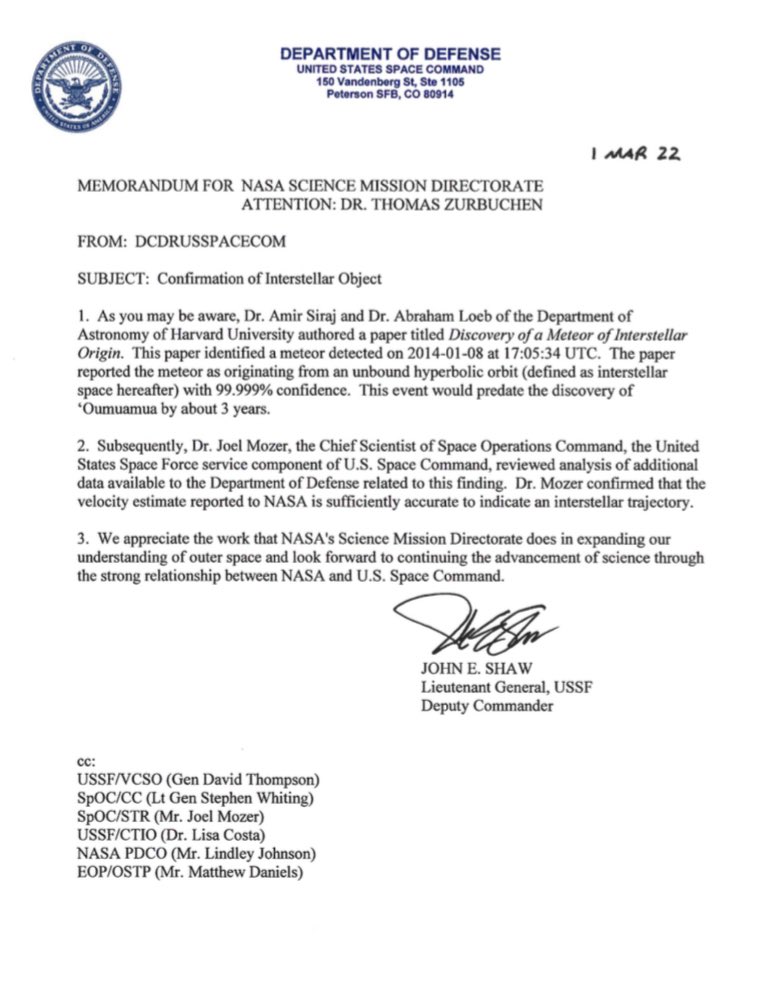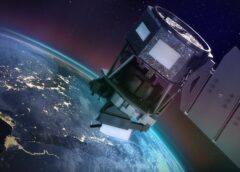U.S. Strategic Command officials confirmed Wednesday that a small meteor that crashed of the Northeast Coast of Papua New Guinea in 2014 actually traveled from another solar system before splashing down into the Pacific.
With the official name, CNEOS 2014-01-08, the meteor crashed on Jan. 8, 2014 with an energy equivalent to about 110 metric tons of TNT into the depths of the ocean.
CNEOS 2014-01-08 was identified as an interstellar meteor in a 2019 study co-written by an undergraduate student at Harvard University, a professor of science at Harvard.
The U.S. Space Command released a document regarding the discovery, where U.S. Space Force Lt. Gen. John Shaw stated that officials reviewed additional data and confirmed that the velocity estimate reported to NASA.

The trajectory of this particular meteor was peculiar, along with the extremely high velocity and unusual direction at which it encountered our planet. So when you put it all together, then the conclusion is that it came from interstellar space.
The fireball was detected by sensors on a classified U.S. government satellite designed to detect foreign missile launches.
The Department of Defense has partnered with NASA and had jointly posted details of the event which were eventuall shared on a public database hosted by the Center for Near Earth Object Studies (CNEOS) within the space agency’s Jet Propulsion Laboratory (JPL).
- Scientists discover what was on the menu of the first dinosaurs
 The earliest dinosaurs included carnivorous, omnivorous and herbivorous species, according to a team of University of Bristol palaeobiologists.
The earliest dinosaurs included carnivorous, omnivorous and herbivorous species, according to a team of University of Bristol palaeobiologists. - Experiencing the UFO Experience
 Rebeca and I recently paid a visit to a new exhibit in the valley… Scottsdale, Arizona – Tuesday, December 13, 2022/ There’s a new venue that just … Experiencing the UFO Experience Rod WashingtonRod is a blogger, writer, filmmaker, photographer, daydreamer who likes to cook. Rod produces and directs the web series, CUPIC: Diary of… Read more: Experiencing the UFO Experience
Rebeca and I recently paid a visit to a new exhibit in the valley… Scottsdale, Arizona – Tuesday, December 13, 2022/ There’s a new venue that just … Experiencing the UFO Experience Rod WashingtonRod is a blogger, writer, filmmaker, photographer, daydreamer who likes to cook. Rod produces and directs the web series, CUPIC: Diary of… Read more: Experiencing the UFO Experience - NASA Confirms Discovery of Challenger Debris
 According to a NASA press release, NASA leaders recently viewed footage of an underwater dive off the East coast of Florida, and they confirm it depicts an artifact from the space shuttle Challenger. TNCRod Washington: Rod is a blogger, writer, filmmaker, photographer, daydreamer who likes to cook. Rod produces and directs the web series, CUPIC: Diary… Read more: NASA Confirms Discovery of Challenger Debris
According to a NASA press release, NASA leaders recently viewed footage of an underwater dive off the East coast of Florida, and they confirm it depicts an artifact from the space shuttle Challenger. TNCRod Washington: Rod is a blogger, writer, filmmaker, photographer, daydreamer who likes to cook. Rod produces and directs the web series, CUPIC: Diary… Read more: NASA Confirms Discovery of Challenger Debris - SpaceX lit up the Sky last night with a Starlink Launch from Vandenberg
 SpaceX launched its Falcon 9 rocket Thursday night from Vandenberg Space Force Base in California… The rocket launch produced a spectacular sight in … SpaceX lit up the Sky last night with a Starlink Launch from Vandenberg Rod WashingtonRod is a blogger, writer, filmmaker, photographer, daydreamer who likes to cook. Rod produces and directs the… Read more: SpaceX lit up the Sky last night with a Starlink Launch from Vandenberg
SpaceX launched its Falcon 9 rocket Thursday night from Vandenberg Space Force Base in California… The rocket launch produced a spectacular sight in … SpaceX lit up the Sky last night with a Starlink Launch from Vandenberg Rod WashingtonRod is a blogger, writer, filmmaker, photographer, daydreamer who likes to cook. Rod produces and directs the… Read more: SpaceX lit up the Sky last night with a Starlink Launch from Vandenberg - District of Columbia Teams Up with Plenary Americas, ENGIE North America, and EQUANS for Nation’s Largest Urban Streetlight Modernization Project
 $309 Million Project will Modernize More Than 75,000 Streetlights, Reduce Energy Use by more than 50 Percent, Improve Equity of Service, and Extend Wi-Fi Coverage in Underserved Neighborhoods
$309 Million Project will Modernize More Than 75,000 Streetlights, Reduce Energy Use by more than 50 Percent, Improve Equity of Service, and Extend Wi-Fi Coverage in Underserved Neighborhoods

Rod is a blogger, writer, filmmaker, photographer, daydreamer who likes to cook. Rod produces and directs the web series, CUPIC: Diary of an Investigator. He is also the editor, producer and administrator of STM Daily News, a part of the TNC Network.


